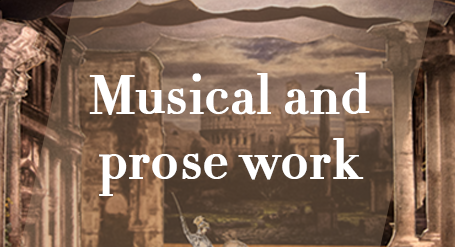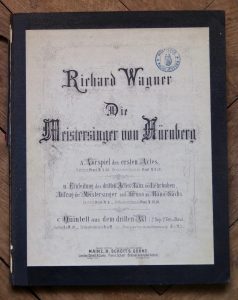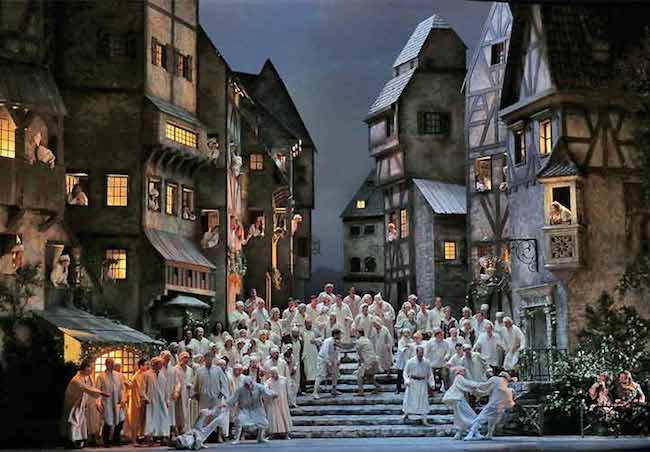
The musical work of Richard Wagner is composed of operas or “musical dramas” ranging from “Fairies” (Die Feen) to “Parsifal”. A detailed presentation of each of these major works is associated here with a set of thematic articles, placing them not only in the context of his personal life but also in his social, economic and cultural context. This section also includes all the musical works (excluding opera) and his literary work.
The Master-Singers of Nuremberg, WWV96
Die Meistersinger von Nürnberg, WWV96
Music drama in three acts
Libretto and music by Richard Wagner
Premiere :
21. June 1868, Munich (Royal Court and National Theatre)
Cast :
HANS SACHS (bass)
VEIT POGNER (bass)
KUNZ VOGELSANG (tenor)
KONRAD NACHTIGALL (bass)
SIXTUS BECKMESSER (bass)
FRITZ KOTHNER (bass)
BALTHASAR ZORN (tenor)
ULRICH EISSLINGER (tenor)
AUGUSTIN MOSER (tenor)
HERMANN ORTEL (bass)
HANS SCHWARZ (bass)
HANS FOLTZ (bass)
WALTHER VON STOLZING (tenor)
DAVID (tenor)
EVA (soprano)
MAGDALENE (mezzo-soprano)
NIGHT-WATCHMAN (bass)
Citizens of all guilds and their wives, journeymen, apprentices, young women, people of Nuremberg (chorus)
The action takes place in Nuremberg, towards the middle of the sixteenth century.
Duration : from 4hrs to 4.45hrs (depending on conductors)
![]()
 The Master-Singers of Nuremberg (Die Meistersinger von Nürnberg, WWV96) is the eighth of Richard Wagner’s operas and the only “comedy in music” of the composer.
The Master-Singers of Nuremberg (Die Meistersinger von Nürnberg, WWV96) is the eighth of Richard Wagner’s operas and the only “comedy in music” of the composer.
Created after the very pessimistic Tristan and Isolde, The Master-Singer sresolutely display a much lighter, even burlesque tone sometimes, rather unusual in the traditional Wagnerian repertoire. It is also the only opera by Wagner that fits faithfully in a historical setting: that of Nuremberg in the middle of the XVIth century. The work shows a central figure having really existed, the shoemaker and poet Hans Sachs (1494-1576), a character sometimes serious, sometimes sarcastic, but always full of kindness, for whom Wagner composed two monologues that are among the most beautiful pages written for a bass-baritone.
Since its creation, the opera has been one of the most resounding successes in the composer’s lifetime. As it is full of exhortations to the popular hymn, the Third Reich did not hesitate to appropriate this work later, which can easily be understood as a cult to German art, distorting the original message – from a European context of nationalist awakenings- into pro-German propaganda.
Although Richard Wagner did not really concern himself with the writing of the libretto until 1861, the composer had already taken an interest in the story of Hans Sachs and the fraternity of The Master-Singers as well as the strict rules regarding the poetic writing (those of the Tabulatur) of which they were the guarantors, particularly during his summer stay in Marienbad in July 1845. But it was after the debacle of the production of Tannhäuserin March 1861 at the Paris Opera, when he was in disarray and tried to haveTristan and Isolde staged, that Wagner got on with a less bleak task than the previous one, renewing with the tradition of The Master-Singers whom he had already approached for the subject of his Tannhäuser.
“I understood Hans Sachs as the last incarnation of the artistically creative spirit,” wrote Wagner immediately after his discovery of the character considered in his time as the most gifted and famous of The Master-Singers. (read more…)
If you wish to share further information about this article, please feel free to contact us !
